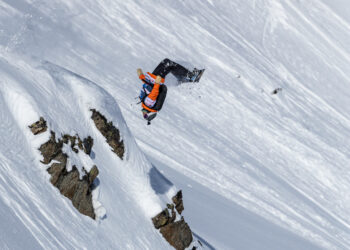By Patrick Straub EBS FISHING COLUMNIST
There is snow on the mountains and most of the leaves have changed. For anyone clinging to summer, get over it. It is time to get serious about the fall angling season. And, for anglers looking to get more out of their fall fishing, it is important to have the right gear. Flip-flops and short sleeves can remain in the closet, while gloves and turtlenecks should be on the top of the list.
As I’m deep into the heart of my 23rd year of guiding on our local waters, my list of angling essentials has come in handy nearly each day. Like the mood of a two-year old, fall angling conditions can change rapidly: sunny and calm one minute and stormy and cold the next. Here’s 23 years of experience in one simple list of the seven fall angling essentials.
Windproof fleece stocking cap or beanie. This may seem like a small piece of gear, and it is. However, it is a big bonus to have if the wind kicks up or a shower or snowstorm passes. A stocking cap can be placed easily over a baseball cap and can keep your noggin warm. Choose a windproof variety as well.
Loon Henry’s Sinket. Dry-fly fishing opportunities are a little less frequent in fall—as the main hatches of blue-winged olives and October caddis are sporadic—so there are times when fishing subsurface is the name of the game. However, we may not want to use split shot to get a fly down to the target depth as fast as possible. Loon Outdoors created Henry’s Sinket, a gel that is placed on the fly to help it sink fast. I use this nearly every time I fish a fly I want to sink—from rubber-leg nymphs to streamers to emerger patterns.
Sink-tip fly lines. Larger brown trout can become aggressive as they prepare to spawn. However, often times these fish lie near the bottom. To get a big streamer to sink fast enough to be in the zone where a brown trout may take a swipe, a sink-tip fly line is crucial. Choose the fastest possible sink-rate and if I want the fly to not sink so fast, I will choose a larger, unweighted fly.
Soft and supple tippet for small dry flies. If the blue-winged olives hatch, because the adults are small—usually size 16 to 20—a tiny dry fly is required. In order to obtain the best possible presentation, I fish 5X or 6X and choose a tippet that is fine, supple and soft. These qualities ensure the tippet itself doesn’t cause any drag and allows the tiny fly to float on the surface longer and behave more natural. Rio Suppleflex and TroutHunter Finesse are ideal.
Fingerless gloves. In the past two weeks I’ve worn my fingerless gloves a few days. Maintaining hand-dexterity is crucial to catch more fish. If you can’t move your fingers to mend, strip or set the hook, you might as well be at home on the couch. Too many times I’ve watched anglers miss fish because of cold hands or because of bulky gloves covering their fingers. This is a small addition to your gear arsenal, but invest in a good pair, stuff them in your pocket, and catch more fish.
Sock-liners. These are thin socks that are worn under a warmer sock. They are simple, inexpensive, but go a long way in keeping your feet warm as the temps drop. Another simple hint: make sure your toes are not cramped in your boots. To keep those toesies warm, they must be able to move.
Fluorocarbon tippets and leaders. It pains a dry-fly snob like me to feature fluorocarbon, but, when this material was brought into fly fishing a little over two decades ago, nymph anglers rejoiced. Fluorocarbon is not only important for the two-fly indicator crowd, though; it is nearly crucial to use fluorocarbon for fishing streamers. Fluorocarbon is far more abrasion-resistant than nylon monofilament and sinks faster—two things very important when fishing streamers.
The other morning, still not fully into my coffee, I walked outside in my flip-flops and t-shirt to organize my boat for the day. Like a wooly bugger cast errantly into the back of my head, it hit me: summer is over. But then the excitement kicked in. Fall means small dry-fly fishing and large-fly streamer fishing. I walked back into my house, grabbed the things on the list above, and I didn’t need the rest of my coffee to get excited for the day.
Patrick Straub is a 20-year veteran guide and outfitter on Montana’s waters and has fished the world over. He now writes and manages the social media for Yellow Dog Flyfishing Adventures. He is the author of six books, including “Everything You Always Wanted to Know About Fly Fishing” and has been writing The Eddy Line for seven years.













